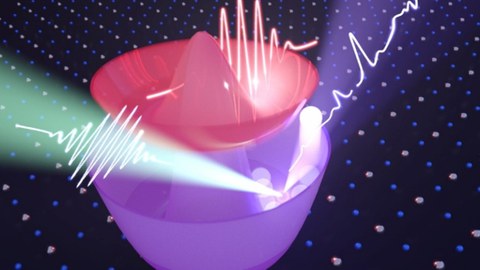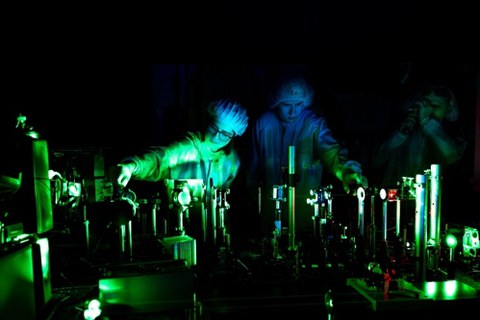01.08.2025
Neuartige experimentelle Methode misst die Higgs-Mode in Hochtemperatursupraleitern
Ein internationales Forschungsteam um Tomke Glier (Universität Hamburg), Stefan Kaiser (TU Dresden), Dirk Manske (Max-Planck-Institut Stuttgart), und Michael Rübhausen (Universität Hamburg) hat mit einer bahnbrechenden experimentellen Methode einen Weg gefunden, die Higgs-Mode in Supraleitern direkt zu messen [1].
In Supraleitern können sich Elektronen auf bemerkenswerte Weise zusammenschließen: Sie bewegen sich kollektiv in einem gemeinsamen Quantenzustand, in dem elektrischer Strom völlig verlustfrei fließt. Forschende können diesen Zustand mit ultrakurzen Laserpulsen gezielt anregen und dadurch ins Schwingen bringen. So entstehen sogenannte Higgs-Moden – kollektive Schwingungen des supraleitenden Zustands selbst. Dabei erinnert der Begriff „Higgs-Moden“ nicht zufällig an das berühmte Higgs-Boson aus der Teilchenphysik: Auch hier geht es um die Schwingung eines Feldes, basierend auf den gleichen physikalischen Prinzipien der Symmetriebrechung. Im Fall der Supraleiter liefert die Higgs-Mode wertvolle Einblicke in die verborgenen Symmetrien und die innere Struktur dieses besonderen Zustands. Man kann sich das Schwingungsspektrum der Higgs-Moden wie den Fingerabdruck eines Supraleiters vorstellen – eine Art charakteristisches Echo, das dessen Eigenschaften sichtbar macht.
Die nun neu entwickelte spektroskopische Methode erlaubt es, Higgs-Moden direkt und gezielt zu beobachten. Das ist ein bedeutender Fortschritt, denn viele zentrale Fragen zur Supraleitung – insbesondere zur sogenannten Hochtemperatur-Supraleitung, die auch bei relativ hohen Temperaturen funktioniert – sind bis heute ungelöst.
„Terahertz-Laser haben in den letzten zehn Jahren große Fortschritte in der experimentellen Higgs-Spektroskopie ermöglicht“ [2], erklärt Stefan Kaiser, Professor an der TU Dresden. „Was bisher jedoch fehlte, war ein präzises Werkzeug zur Untersuchung der Symmetrieeigenschaften dieser Anregungen – genau hier setzt die Raman-Spektroskopie an.“

Eine NEARS Messung am Supraleiter charakterisiert dessen Higgs Mode wie einen Fingerabdruck. Dazu wird die Higgs Mode mit einem Quench-Puls (rot) zu Schwingungen angeregt. Diese können dann durch anti-Stokes Raman Streuung (blau) vollständig in unterschiedlichen Symmetriekanälen charakterisiert werden.
Das Team entwickelte dazu Non-Equilibrium Anti-Stokes Raman Scattering (NEARS). Dabei wird ein gezielter „Soft Quench“ des sogenannten Mexican-Hat-Potenzials ausgelöst, was zu einer kontrollierten Anregung metastabiler Higgs-Zustände führt. „Durch diese Anregung entsteht eine charakteristische Populationsinversion, die sich im Spektrum als zusätzliches Anti-Stokes-Raman-Signal zeigt“, erläutert Tomke Glier, Erstautorin der Studie. „Diese polarisationsabhängige Raman-Spektroskopie ermöglicht es erstmals, die Symmetrie der Higgs-Moden experimentell zu bestimmen – ein entscheidender Schritt“, ergänzt Dirk Manske, der zusammen mit Theoretikern am MPI Stuttgart und innerhalb des Max Planck–UBC–UTokyo Centers für Quantenmaterialien eine Klassifizierung möglicher Higgs-Moden in Supraleitern erstellt hat [3].
Das Team konnte durch die NEARS-Technik erstmals die symmetrieabhängigen Higgs-Moden in A1g- und B1g-Symmetrie bei etwa 25 meV in Bi2Sr2CaCu2O8+x (Bi-2212), einem Hochtemperatursupraleiter, nachweisen. Diese Untersuchung wurde in Abhängigkeit von der Quench-Stärke durchgeführt. Die Ergebnisse zeigen, dass die Energie dieser Moden mit den Kopplungslängen von Cooper-Paaren unter 5 nm in Bi-2212 übereinstimmt. Zudem wurde ein BCS-Modell der elektronischen Ramanstreuung von dem Team um Dirk Manske entwickelt, sowie eine vergleichende Ginzburg-Landau-Theorie angewendet, um die experimentellen Ergebnisse zu unterstützen.

Arbeit im zeitaufgelösten Raman-Labor in Hamburg am Center for Free-Electron Laser Science. Von Links: Tomke Glier, Mika Rerrer, Malte van Heek.
NEARS-Messungen werden an dem einzigartigen, neu entwickelten Raman-Spektrometer in Hamburg am Center for Free-Electron Laser Science (CFEL, Arbeitsgruppe Rübhausen) durchgeführt [4]. Das in Hamburg entwickelte Spektrometer ermöglicht zeitaufgelöste Raman-Spektroskopie in Resonanz mit den entscheidenden Energieskalen der kondensierten Materie. „Diesen großen Spektralbereich in Verbindung mit sehr hoher Energieauflösung bei kleinen Anregungsenergien erreichen wir mit diesem seit vielen Jahren kontinuierlich weiterentwickelten Aufbau“, erklärt Michael Rübhausen.
NEARS eröffnet einen systematischen Zugang zur Analyse von Amplitudenmoden in einer Vielzahl von Quantenkondensaten – von Supraleitern mit konkurrierenden Ordnungen bis hin zu transient induzierten supraleitenden Zuständen oder Interface-Supraleitungen. Die Präsenz der Higgs-Mode kann künftig sogar als Kriterium für eine Supraleitung herangezogen sowie genutzt werden, um Kohärenzlängen und Symmetrien des Ordnungsparameters neuer Supraleiter zu charakterisieren.
Förderung und Danksagung:
Diese Arbeit wurde unterstützt von der Max-Planck-Gesellschaft, dem Bundesministerium für Bildung und Forschung (05K19GU5, 05K22GU2), der Deutschen Forschungsgemeinschaft (SFB 1143 (project id 247310070)), sowie dem Würzburg-Dresden Cluster of Excellence on Complexity and Topology in Quantum Matter (ct.qmat, EXC 2147) und Funding der Europäischen Union (ERC, T-Higgs, GA 101044657). Weitere Untertstützung kam von von der University of British Columbia (Andrea Damascelli) sowie der University of Minnesota (Martin Greven).
References:
[1] Tomke E. Glier, Sida Tian, Mika Rerrer, Lea Westphal, Garret Lüllau, Liwen Feng, Jakob Dolgner, Rafael Haenel, Marta Zonno, Hiroshi Eisaki, Martin Greven, Andrea Damascelli,
Stefan Kaiser, Dirk Manske, Michael Rübhausen; Non-equilibrium anti-Stokes Raman spectroscopy for investigating Higgs modes in superconductors; Nature Commun. 16, 7027 (2025).
[2] Kim, M.-J. et al. Tracing the dynamics of superconducting order via transient terahertz third-harmonic generation. Sci. Adv.10, eadi7598 (2024). DOI:10.1126/sciadv.adi7598
[3] Schwarz, L. et al. Classification and characterization of nonequilibrium Higgs modes in unconventional superconductors. Nat Commun 11, 287 (2020). https://doi.org/10.1038/s41467-019-13763-5
[4] Schulz, B. et al., Fully reflective deep ultraviolet to near infrared spectrometer and entrance optics for resonance Raman spectroscopy. Rev. Sci. Instrum. 76, 073107 (2005). https://doi.org/10.1063/1.1946985
